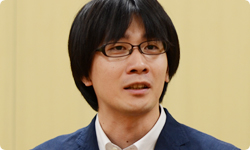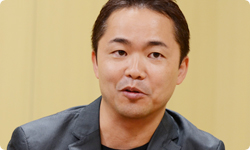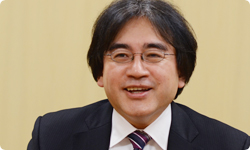(Editor's Note: All videos shown in this interview have been taken from the Japanese version of the game.)
Today, I’m joined by staff from GAME FREAK1 who will be discussing the development of HarmoKnight, a title available to download from Nintendo eShop. I will be asking them about how the idea for the game first came about, and what they would like to say to the fans. Thank you very much for joining me today.1. GAME FREAK inc.: A video game developer founded in 1989. Best known as being the developer of the Pokémon series.
Thank you.
Could I start by asking each of you to briefly introduce yourselves and tell me what your role in this project was? Let’s start with you, Ohmori-san.
My name is Shigeru Ohmori, and I was in charge of the planning of HarmoKnight.

As the person responsible for the planning of the project, was it you who got the ball rolling, defining the kind of game you wanted to make?
No, it was actually James who came up with the initial plan for the game. I joined the project when it was already under way. We put our heads together and thought about how we could make the game as fun as possible, and development progressed from there.
I see. Now, let’s meet James, who came up with initial concept for the project.
My name is James Turner, and I was the director for this project. I came up with the idea for the game about a year and a half ago.

You are originally from England, right?
That’s correct.
How long have you lived in Japan?
I’ve been here for a fair while. This year will be my tenth year in Japan.
And how long is it since you joined GAME FREAK?
I’ve been at the company for three years.
Your Japanese is excellent. I’d love to be able to speak English that fluently! (laughs)
(laughs)
Oh, I think I’ve still got a fair way to go! (laughs)
To direct a project, you need to be able to communicate quite subtle concepts to your staff. Did you ever find that there were things that were difficult to express when you weren’t operating in your native language?
Well, yes. But I was originally a designer...
Ah, so you could always draw pictures in order to clarify things.
Exactly. When it was hard to express an idea verbally, I would often use sketches to explain things visually.
I’m rather envious of your ability to use pictures to get over the language barrier. Next, let’s move on to you, Masuda-san.
My name is Junichi Masuda and I worked as producer on this project. This title came out of a rather special environment. It was a way of doing things that marked a first for us at GAME FREAK.

Could you tell me more about that?
GAME FREAK had come up with original titles such as Drill Dozer2, but we had experienced quite a few problems in the past with getting new projects up and running.2. Drill Dozer: An action platform game developed by GAME FREAK and released by Nintendo for Game Boy Advance. It was released in September 2005 in Japan and February 2006 in the US, but was never released in Europe.
Well, you have the weight of expectations of all the Pokémon fans out there who want you to focus on making great titles for that series.
Yes, and we are absolutely committed to meeting our fans’ expectations. We can’t exactly leave Pokémon to one side while we work on other games! (laughs)
(laughs)
This is why we decided to change the internal structure of the company so that we could initiate new projects while still being able to give our all on Pokémon titles. We have structured things so that if you come up with an idea for a game, you can write a proposal for it;if you can then get two other people to support it, you will be given three months to make it.
I see. So you have made specific rules, along the lines of Google’s ‘20 percent time’3 concept. Is any member of your staff free to work on coming up with a game?3. ’20 percent time’: Google allow their development staff to devote 20 percent of their working hours to their own pet projects.
Yes, that’s right. Anyone can work on developing a game, as long as you can find two other people prepared to come on board with the project. Then, after three months, we will check on the game’s progress.
So you check to see whether or not the project is worth continuing.
That’s right. And if we think it’s worth pursuing, we will give the team another three months to work on it. Then, six months after work begins on a game, the management will make a decision as to whether or not to turn it into a full-blown project. HarmoKnight is the first fruit of our company’s new system, which encourages people who have an idea to just give it a go.
Ah, I see. Back when you and I began working in game development, that would very much be the attitude: ‘Just give it a go!’ That was how projects would get started.

Yes, absolutely. In the old days, games would get started as tiny projects. You’d often just be toying with some idea or other that seemed like fun, and then you’d decide to take it further and make it into a game.
I first got involved in game development back when you were expected to come up with a new title every three months. It’s unthinkable nowadays! (laughs)
It really is! (laughs) But it is so much fun to have just a few of handful of people working on turning your very own idea into a game.
Absolutely! (laughs)
Due to the sheer scale of the Pokémon projects we are working on now, there is a tendency for members of the dev team to focus solely on the area they are responsible for. This is something that’s difficult to avoid. But back in the old days, teams would be small and people would work on all sorts of different aspects of the project. It’s difficult to bring home the importance of this kind of approach to our staff, so we concluded that it would be best to get them to experience it for themselves and we changed the system accordingly. This means that the team aren’t simply waiting to be told what to do, but are proactively coming up with ideas of their own. It’s positive as our staff tend to become more focused on their work.
So I guess that the experience your staff gain from working on their own projects will be utilised in future Pokémon titles.
Yes, that’s right.
So what was the initial idea you came up with, James?
Well, when it comes to both design and game systems, I like things to be simple. So I initially wanted to make a very simple action platformer. I was thinking about how to make it as simple as possible, and I decided that using just a single button to play would make it appealing even to people who aren’t very good at video games. It presented a really interesting challenge.
So you didn’t originally plan to make a rhythm game?
No, I didn’t. But the more I thought about it, the more fun I thought it would be to make a simple platformer that was also a rhythm game. So my initial plan for the project was to make a rhythm platform game that used just the A and B Buttons.
Yes, that’s right.
If you simply read about a game with single button controls, it might well leave you a little confused, but with images, it’s much easier to communicate the concept, and everyone who saw it thought it looked really fun. The drawings in the plan were also very striking, and those images stayed with the people who saw them. Once the team had grasped the concept, they were faithful to it right until the very end.
Yes, that’s right. The overall concept of making it easy to play was something we never deviated from.
However, in the end we decided to use the A Button to hit and the B Button to jump, with occasional use of the +Control Pad.
But even so, it’s still really simple.
There’s no doubt about that! (laughs)
© 2024 Nintendo.